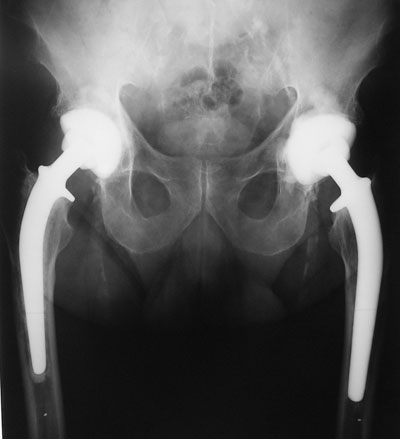Researchers tout the advantages of ceramic-on-ceramic hip bearings
Ceramic-on-ceramic bearings have shown excellent long-term outcomes, with no osteolysis or adverse biological effects, according to Laurent Sedel, MD, of Hopital Lariboisiere, University Denis Diderot Paris.
Sedel presented an overview of ceramic-on-ceramic hip bearings and a 20-year study on the coupling at the SICOT XXV Triennial World Congress 2011.
“The advantages of ceramic-on-ceramic are great,” Sedel said. “This couple does not present any biological adverse effects, no allergic response, no elevation of chromium or cobalt in the blood and no problems regarding pregnancy or renal insufficiency.”
In a 20-year follow-up study, Sedel contacted all of his surviving patients who had ceramic-on-ceramic total hip arthroplasties (THAs) and had them assessed by an independent observer who evaluated the group using the Merle D’Aubigne score.
“Overall survivorship is 88% at 20 years,” Sedel said in his presentation at SICOT. “If you look at failures related only to materials, it is 91% at 20 years.”
The main reason for revision was aseptic loosening of the acetabular component. Other complications included two component fractures, one each for the head and liner.
Sedel recalled that in the 1970s, Pierre Boutin, MD, — the first to implant such a material — experienced problems with ceramic-on-ceramic, which included fractures and difficulty in ensuring the bond between the ceramic and metal.
Sedel’s team worked with German researchers to create a taper lock design to solve this problem. In 1977, Sedel and his team implanted the first ceramic THA with a cemented socket.
Sedel and his team realized the ceramic material was not perfect and may pose a fracture risk. They worked with Ceraver Company to improve the design, choosing a larger size for the ceramic head.
Sedel then discovered complications related to the fixation of the socket. The team’s first solution to this problem was to use metal backings with a screw-in design, but this gave rise to some failures. The team then modified the bearing in 1989 to a press-fit design. After this modification, results improved dramatically, Sedel said.
Thirty-four years ago, Sedel introduced a cemented stem made of a titanium alloy and covered with titanium oxide. The survivorship of these stems was 99% at 10 years and 96% at 20 years, Sedel said.
|
Image: Sedel L |
During a 38-year period, Sedel and his team noted more loosening of the acetabular component in elderly patients.
“In the elderly, we observed more failures that we attributed to the hardness of the material implanted in osteoporotic bone,” Sedel said. “It was then that we changed our strategy and began using this material only for young and active patients.”
Ten years ago, Sedel began to push for the use of ceramic bearings in older patients.
“Some patients, even at 75 years old, are included if they are still active and performing or willing to perform some sports,” Sedel said.
The risks of metal debris prompted Sedel to use alumina-on-alumina bearings for THAs instead of metal-on-polyethylene designs. He allows patients who have had an alumina-on-alumina THA to perform strenuous activities without limitations. Fracture risk of these bearings is low, Sedel said, with less than one in 2,000 patients at 10-year follow-up.
Researchers have reported audible contact noise in 10% of patients, “but it was limited in time and intensity and was never a reason for revision,” according to Sedel. – by Renee Blisard
Reference:
- Sedel L. International Hip Society Symposium: Bearng couples. Ceramic-ceramic. Presented at the SICOT XXV Triennial World Congress 2011. Sept. 6-9. Prague.

- Laurent Sedel, MD, can be reached at Hopital Lariboisiere, University Denis Diderot Paris, France; email: laurent.sedel@lrb.aphp.fr.
- Disclosure: Sedel is a consultant for Ceraver Company.
|
|
Wear and osteolysis are the most concerns for long-term survival in total hip arthroplasty. Nowadays, metal-on-metal articulations for both resurfacing hip replacement and total hip replacement are faced with more than expected clinical failure rates and wear related to soft tissue reactions. Therefore, ceramic-on-ceramic articulations have gained more importance and clinical use in the last years.
The data presented by Prof. Sedel show excellent long-term survival of his ceramic articulation, despite the fact that this was not the high quality standard ceramics we have nowadays. Delta ceramic has especially gained increasing use as improvement of the ceramic material allows larger femoral heads and reduces the risk of ceramic fracture dramatically.
Prof. Sedel’s data are stimulating the use of this hard-on-hard bearing articulation, which is now accepted worldwide as material with optimal wear characteristics to achieve excellent long-term clinical results.
— Karl Knahr, MD
Orthopaedics Today
Europe Editorial Board member
Vorstand der Abteilung Orthopädie
II
Orthopädisches Spital Speising GmbH
Vienna, Austria
Disclosure: Knahr has no relevant financial disclosures.










